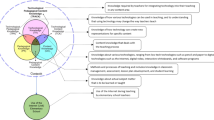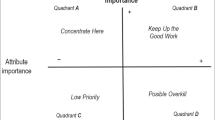Abstract
This study validated the semantic items of three related scales aimed at characterising the perceived worth of mathematics-education-related mobile applications (apps). The technological pedagogical content knowledge (TPACK) model was used as the conceptual framework for the analysis. Three hundred and seventy-three preservice students studying primary school education from two public and one private Australian universities participated in the study. The respondents examined three different apps using a purposively designed instrument in regard to either their explorative, productive or instructive instructional role. While construct validity could not be established due to a broad range of variability in responses implying a high degree of subjectivity in respondents’ judgments, the qualitative analysis was effective in establishing content validity.


Similar content being viewed by others
References
Anderson, L. W., & Krathwohl, D. R. (Eds.). (2001). A taxonomy for learning, teaching and assessing: a revision of Bloom’s taxonomy of educational objectives. New York: Longman.
Attard, C. (2013). Integrating iPads into primary mathematics pedagogies: an exploration of two teachers’ experiences. In V. Steinle, L. Ball, & C. Bardini (Eds.), Mathematics education: yesterday, today and tomorrow (proceedings of the 36th annual conference of the Mathematics Education Research Group of Australasia) (pp. 58–65). Melbourne, VIC: MERGA.
Attard, C., & Curry, C. (2012). Exploring the use of iPads to engage young students with mathematics. In J. Dindyal, L. P. Cheng, & S. F. Ng (Eds.), Mathematics education: expanding horizons (proceedings of the 35th annual conference of the Mathematics Education Research Group of Australasia) (pp. 75–82). Singapore: MERGA.
Australian Curriculum, Assessment and Reporting Authority (ACARA). Australia Curriculum. http://www.australiancurriculum.edu.au/mathematics/curriculum/f-10?layout=1
Baya’a, N., & Daher, W. (2009). Students’ perceptions of mathematics learning using mobile phones. Paper presented at the IMCL2009, Jordan.
Calder, N. (2015). Apps: appropriate, applicable and appealing? In T. Lowrie & R. Jorgensen (Eds.), Digital games and mathematics learning: potential, promises and pitfalls. The Netherlands: Springer.
Churchill, D., & Churchill, N. (2008). Educational affordances of PDAs: a study of a teacher’s exploration of this technology. Computers & Education, 50(4), 1439–1450.
Cohen, L., Manion, L., & Morrison, K. (2007). Research methods in education (6th ed.). New York, NY: Routledge.
Education Services Australia. (2014). Fraction fiddle: reach the target. Retrieved from: https://www.scootle.edu.au
Franklin, T., & Peng, L. W. (2008). Mobile math: math educators and students engage in m-learning. Journal of Computing in Higher Education, 20(2), 69–80.
Handal, B. (2015). Mobile makes learning free: building conceptual, professional and school capacity. in Gene Glass (Ed). North Carolina: Information Age Publishing
Handal, B., Campbell, C., Cavanagh, M., Petocz, P., & Kelly, N. (2012). Integrating technology, pedagogy and content in mathematics education. Journal of Computers in Mathematics and Science Teaching, 31(4), 387–413.
Handal, B., El-Khoury, J., Cavanagh, M., & Campbell, C. (2013). A framework for categorising mobile learning applications in mathematics education. Proceedings of the Australian Conference on Science and Mathematics Education (pp. 142–147). Canberra: IISME. Retrieved from: http://ojs-prod.library.usyd.edu.au/index.php/IISME/article/view/6933
Handal, B., Campbell, C., Cavanagh, M., Petocz, P., & Kelly, N. (2013). Pedagogical content knowledge (TPACK) of secondary mathematics teachers. Contemporary Issues in Technology and Teacher Education, 13(1). Retrieved from :http://www.citejournal.org/vol13/iss1/mathematics/article1.cfm
Handal, B., Campbell, C., Cavanagh, M., & Dave, K. (2014). Appraising maths apps using the TPACK model. 15th Australasian Computer Education Conference, Adelaide, South Australia (pp. 169–187).
Jonas-Dwyer, D., Clark, C., Celenza, A., & Siddiqui, Z. (2012). Evaluating apps for learning and teaching. International Journal of Emerging Technologies in Learning (iJET), 7(1), 54–57.
Kearney, M., Shuck, S., Burden, K., & Aubusson, P. (2012). Viewing mobile learning from a pedagogical perspective. Research in Learning Technology, 20, 1–17.
Kiekel, J., & Kirk, E. (2013). Evaluating apps to ensure learning outcomes. In R. McBride & M. Searson (Eds.), Proceedings of Society for Information Technology & Teacher Education International Conference 2013 (pp. 2171–2174). Chesapeake, VA: Association for the Advancement of Computing in Education (AACE).
Koehler, M. J., & Mishra, P. (2008). Introducing TPCK. In The AACTE Committee on Innovation and Technology (Eds.), Handbook of technological pedagogical content knowledge for educators (pp. 1–29). New York, NY: Routledge.
Larkin, K. (2015). “An App! An App! My Kingdom for An App”: an 18-month quest to determine whether apps support mathematical knowledge building. In T. Lowrie & R. Jorgensen (Eds.), Digital games and mathematics learning: potential, promises and pitfalls. Vol. 4 (pp. 251–276). Netherlands: Springer.
Learnbat Inc. (2015). ShowMe Interactive Whiteboard. Retrieved from: http://www.showme.com/
Lee, H., & Hollebrands, K. (2008). Preparing to teach mathematics with technology: an integrated approach to developing technological pedagogical content knowledge. Contemporary Issues in Technology and Teacher Education, 8(4), 326–341.
Lyublinskaya, I., & Tournaki, N. (2011). The effects of teacher content authoring on TPACK and on student achievement in algebra: research on instruction with the TI-Nspire™ Handheld. Educational Technology, Teacher Knowledge, and Classroom Impact: A Research Handbook on Frameworks and Approaches, 295
MacCallum, K., & Jeffrey, L. (2009). Identifying discriminating variables that determine mobile learning adoption by educators: an initial study. Same places, different spaces. Proceedings ASCILITE Auckland 2009.
Muijs, D. (2011). Doing quantitative research in education with SPSS. Niess: Sage.
Niess, M. L., Ronau, R. N., Shafer, K. G., Driskell, S. O., Harper, S. R., Johnston, C., Browning, C., Özgün-Koca, A., & Kersaint, G. (2009). Mathematics Teacher TPACK Standards and Development Model. Contemporary Issues in Technology and Teacher Education (CITE Journal), 9(1), 4–24.
Niess, M. L., van Zee, E. H., & Gillow-Wiles, H. (2011). Knowledge growth in teaching mathematics/science with spreadsheets: moving PCK to TPACK through online professional development. Journal of Digital Learning in Teacher Education, 27(2), 42–52.
Regular Berry Software LLC (2013). Long Division Touch. Retrieved from: http://www.regularberry.com/
Schmidt, D. A., Baran, E., Thompson, A. D., Mishra, P., Koehler, M. J., & Shin, T. S. (2009). Technological pedagogical content knowledge (TPACK): the development and validation of an assessment instrument for preservice teachers. Journal of Research on Computing in Education, 42(2), 123.
Schulman, L. S. (1986). Those who understand: knowledge growth in teaching. Educational Researcher, 15(2), 414.
Schulman, L. S. (1987). Knowledge and teaching: foundations for a new reform. Harvard Educational Review, 57(1), 1–22.
Sollarvall, H., Gildelaiglesia, D., Milrad, M., Peng, A., Pettersson, O., SalavatiI, S., & Yau, J. (2011). Trade-offs between pedagogical and technological design requirements affecting the robustness of a mobile learning activity. Paper presented at the 19th International Conference on Computers in Education, Chiang Mai, Thailand
Sollarvall, H., Otero, N., Milrad, M., Johansson, D., & Vogel, B. (2012, March 27–30). Outdoor activities for the learning of mathematics: designing with mobile technologies for transitions across learning contexts. Paper presented at The 7th IEEE International conference on wireless, mobile and ubiquitous technology in education. Takamatsu, Kagawa, Japan.
Spencer, P. (2013). iPads: improving numeracy learning in the early years. In V. Steinle, L. Ball, & C. Bardini (Eds.), Mathematics education: yesterday, today and tomorrow (proceedings of the 36th annual conference of the Mathematics Education Research Group of Australasia) (pp. 610–617). Melbourne, VIC: MERGA.
Thomas, M. O. J., & Hong, Y. Y. (2013). Teacher integration of technology into mathematics learning. International Journal of Technology for Mathematics Education, 20(2), 69–84.
Urban-Woldron, H. (2013). Integration of digital tools into the mathematics classroom: a challenge for preparing and supporting the teacher. International Journal for Technology in Mathematics Education, 20(3), 115–123.
Watlington, D. (2011). Using iPod Touch and iPad educational apps in the classroom. In Society for Information Technology & Teacher Education International Conference, Vol. 1 (pp. 3112–3114).
Webb, D.C. (2013). Bloom’s taxonomy in mathematics education. In Steve Lerman (Editor-in-Chief), Encyclopedia of Mathematics Education. Springer. Retrieved from: http://www.springerreference.com/docs/html/chapterdbid/313196.html
Author information
Authors and Affiliations
Corresponding author
Rights and permissions
About this article
Cite this article
Handal, B., Campbell, C., Cavanagh, M. et al. Characterising the perceived value of mathematics educational apps in preservice teachers. Math Ed Res J 28, 199–221 (2016). https://doi.org/10.1007/s13394-015-0160-0
Received:
Revised:
Accepted:
Published:
Issue Date:
DOI: https://doi.org/10.1007/s13394-015-0160-0




